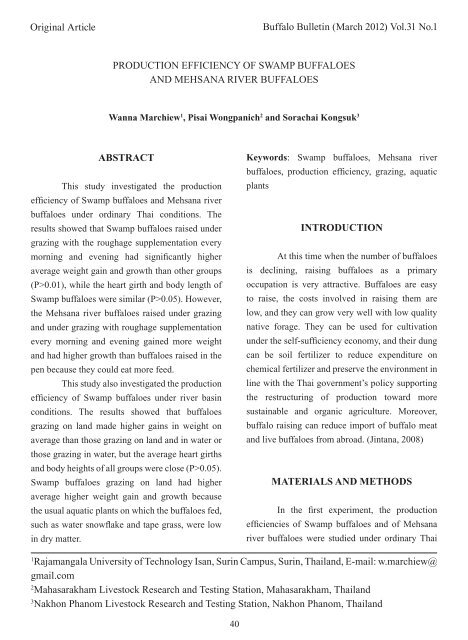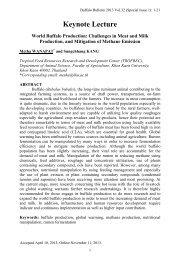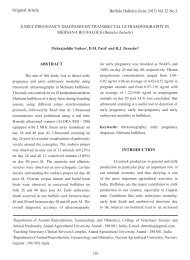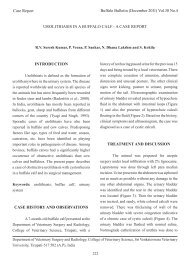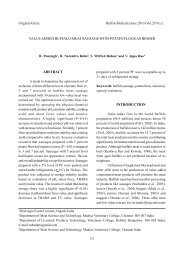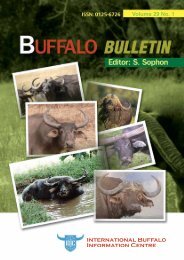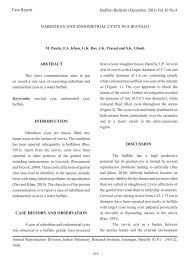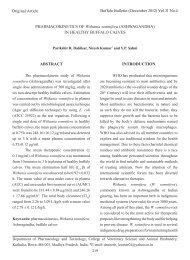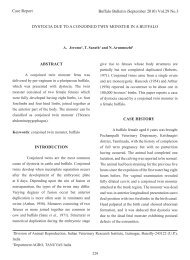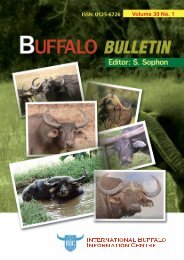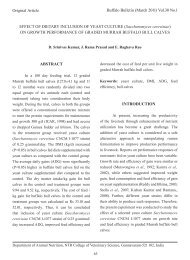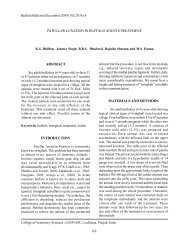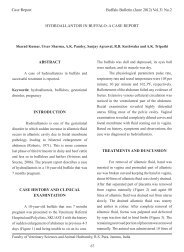Production efficiency of Swamp buffaloes and Mehsana river buffaloes
Production efficiency of Swamp buffaloes and Mehsana river buffaloes
Production efficiency of Swamp buffaloes and Mehsana river buffaloes
Create successful ePaper yourself
Turn your PDF publications into a flip-book with our unique Google optimized e-Paper software.
Original ArticleBuffalo Bulletin (March 2012) Vol.31 No.1PRODUCTION EFFICIENCY OF SWAMP BUFFALOESAND MEHSANA RIVER BUFFALOESWanna Marchiew 1 , Pisai Wongpanich 2 <strong>and</strong> Sorachai Kongsuk 3ABSTRACTThis study investigated the production<strong>efficiency</strong> <strong>of</strong> <strong>Swamp</strong> <strong>buffaloes</strong> <strong>and</strong> <strong>Mehsana</strong> <strong>river</strong><strong>buffaloes</strong> under ordinary Thai conditions. Theresults showed that <strong>Swamp</strong> <strong>buffaloes</strong> raised undergrazing with the roughage supplementation everymorning <strong>and</strong> evening had significantly higheraverage weight gain <strong>and</strong> growth than other groups(P>0.01), while the heart girth <strong>and</strong> body length <strong>of</strong><strong>Swamp</strong> <strong>buffaloes</strong> were similar (P>0.05). However,the <strong>Mehsana</strong> <strong>river</strong> <strong>buffaloes</strong> raised under grazing<strong>and</strong> under grazing with roughage supplementationevery morning <strong>and</strong> evening gained more weight<strong>and</strong> had higher growth than <strong>buffaloes</strong> raised in thepen because they could eat more feed.This study also investigated the production<strong>efficiency</strong> <strong>of</strong> <strong>Swamp</strong> <strong>buffaloes</strong> under <strong>river</strong> basinconditions. The results showed that <strong>buffaloes</strong>grazing on l<strong>and</strong> made higher gains in weight onaverage than those grazing on l<strong>and</strong> <strong>and</strong> in water orthose grazing in water, but the average heart girths<strong>and</strong> body heights <strong>of</strong> all groups were close (P>0.05).<strong>Swamp</strong> <strong>buffaloes</strong> grazing on l<strong>and</strong> had higheraverage higher weight gain <strong>and</strong> growth becausethe usual aquatic plants on which the <strong>buffaloes</strong> fed,such as water snowflake <strong>and</strong> tape grass, were lowin dry matter.Keywords: <strong>Swamp</strong> <strong>buffaloes</strong>, <strong>Mehsana</strong> <strong>river</strong><strong>buffaloes</strong>, production <strong>efficiency</strong>, grazing, aquaticplantsINTRODUCTIONAt this time when the number <strong>of</strong> <strong>buffaloes</strong>is declining, raising <strong>buffaloes</strong> as a primaryoccupation is very attractive. Buffaloes are easyto raise, the costs involved in raising them arelow, <strong>and</strong> they can grow very well with low qualitynative forage. They can be used for cultivationunder the self-sufficiency economy, <strong>and</strong> their dungcan be soil fertilizer to reduce expenditure onchemical fertilizer <strong>and</strong> preserve the environment inline with the Thai government’s policy supportingthe restructuring <strong>of</strong> production toward moresustainable <strong>and</strong> organic agriculture. Moreover,buffalo raising can reduce import <strong>of</strong> buffalo meat<strong>and</strong> live <strong>buffaloes</strong> from abroad. (Jintana, 2008)MATERIALS AND METHODSIn the first experiment, the productionefficiencies <strong>of</strong> <strong>Swamp</strong> <strong>buffaloes</strong> <strong>and</strong> <strong>of</strong> <strong>Mehsana</strong><strong>river</strong> <strong>buffaloes</strong> were studied under ordinary Thai1Rajamangala University <strong>of</strong> Technology Isan, Surin Campus, Surin, Thail<strong>and</strong>, E-mail: w.marchiew@gmail.com2Mahasarakham Livestock Research <strong>and</strong> Testing Station, Mahasarakham, Thail<strong>and</strong>3Nakhon Phanom Livestock Research <strong>and</strong> Testing Station, Nakhon Phanom, Thail<strong>and</strong>40
Buffalo Bulletin (March 2012) Vol.31 No.1conditions using 24 females 18-36 months <strong>of</strong> agefor experimentation. They were divided into threegroups: Group 1 animals were grazed, Group 2were grazed <strong>and</strong> given roughage supplementationevery morning <strong>and</strong> evening, <strong>and</strong> Group 3 were penraised. The experiment lasted 120 days.In the second experiment, the productionefficiencies <strong>of</strong> <strong>Swamp</strong> <strong>buffaloes</strong> were studied under<strong>river</strong> basin conditions. Nine males, 18-36 months<strong>of</strong> age, were divided into three groups. Group 1were grazed on l<strong>and</strong>, Group 2 were grazed on l<strong>and</strong>for 4 h a day <strong>and</strong> in water for 4 h a day, <strong>and</strong> Group 3were grazed in water for 8 h a day. The experimentlasted 120 days.The data <strong>of</strong> the two experiments wereanalyzed statistically using analysis <strong>of</strong> variance <strong>of</strong>r<strong>and</strong>omized complete block design to compare theaverages using Duncan’s new multiple range test.(Steel <strong>and</strong> Torrie, 1980).RESULTS AND DISCUSSIONThe production <strong>efficiency</strong> <strong>of</strong> <strong>Swamp</strong> <strong>buffaloes</strong><strong>and</strong> <strong>Mehsana</strong> <strong>river</strong> <strong>buffaloes</strong> under ordinaryconditionsThe <strong>Production</strong> Effi ciency <strong>of</strong> <strong>Swamp</strong> <strong>buffaloes</strong>Group 2 <strong>buffaloes</strong>, given roughagesupplementation, consumed 23.10 to 29.75 kg <strong>of</strong>fresh roughage (Napier grass) a day, <strong>and</strong> Group 3<strong>buffaloes</strong>, raised in a pen, consumed 34.90 to 38.80kg <strong>of</strong> fresh roughage a day (13.20 percent bodyweight). These groups <strong>of</strong> <strong>buffaloes</strong> ate native grass<strong>and</strong> Napier grass, which are low in nutrients (Table1).Group 2 <strong>buffaloes</strong>, which were given someroughage supplementation, gained more weight <strong>and</strong>had a higher rate <strong>of</strong> growth (P0.05) because they were at growthage <strong>and</strong> the amounts <strong>of</strong> food eaten were not verydifferent. This amount <strong>of</strong> feed could not produce adifference (Table 2).The production effi ciency <strong>of</strong> <strong>Mehsana</strong> <strong>river</strong><strong>buffaloes</strong>The <strong>buffaloes</strong> <strong>of</strong> Group 2, given roughagesupplementation, consumed 20-25 kg <strong>of</strong> freshroughage (Napier grass) a day while the pen-raisedGroup 3 <strong>buffaloes</strong>, ate 40 - 45 kg (12.82 percentbody weight) <strong>of</strong> fresh roughage a day. These<strong>buffaloes</strong> ate Ruzi grass, which is low in nutrients.(Table 1)Group 1 <strong>buffaloes</strong>, raised by grazing, <strong>and</strong>Group 2 <strong>buffaloes</strong>, raised by grazing with roughagesupplementation, gained more weight <strong>and</strong> had ahigher rate <strong>of</strong> growth (P0.05), but there wastendency for Group 3 <strong>buffaloes</strong>, raised in a pen, tohave a higher hearth girth than either the grazedGroup 1 <strong>of</strong> the grazed <strong>and</strong> supplemented Group 2.The average gains in body height <strong>of</strong> the<strong>buffaloes</strong> <strong>of</strong> Groups 1 <strong>and</strong> 2 were greater (P
Buffalo Bulletin (March 2012) Vol.31 No.1Table 1. Chemical Composition <strong>of</strong> Different types <strong>of</strong> Roughage (%).Kinds <strong>of</strong> Roughage Dry Matter Protein Fat Ash NDF ADFNative Grass 27.20 5.07 0.97 7.55 71.47 43.48Ruzi Grass 27.79 5.81 0.98 8.94 71.89 42.97Napier grass 22.39 5.83 1.42 8.24 68.42 49.54Tape grass 4.35 6.85 0.73 8.47 71.62 46.78Water Snowflake 8.34 11.64 1.10 7.81 68.42 51.82Table 2. <strong>Production</strong> <strong>efficiency</strong> <strong>of</strong> <strong>Swamp</strong> <strong>buffaloes</strong>.Group 1 Group 2 Group 3Period <strong>of</strong> experimentation (days) 120 120 120Average weight gain (kg) 42.94 b 68.25 a 61.25 aRate <strong>of</strong> growth (g/day) 357.81 b 568.75 a 510.42 aHeart girth gain (cm) 11.21 11.84 9.50Body length gain (m) 14.00 15.53 14.94Body height gain (cm) 5.45 5.92 6.38Different superscripts in a row show a significant difference (P
Buffalo Bulletin (March 2012) Vol.31 No.1Table 4. Comparison <strong>of</strong> production <strong>efficiency</strong> <strong>of</strong> <strong>Swamp</strong> <strong>buffaloes</strong> <strong>and</strong> <strong>Mehsana</strong> <strong>river</strong> <strong>buffaloes</strong>.ContentsPeriod <strong>of</strong> experimentation(days)Average weightgain (kg)Rate <strong>of</strong> growth(g/day)Heart girth gain(cm)Body lengthgain (cm)Body heightgain (cm)<strong>Swamp</strong><strong>buffaloes</strong>Grazing Roughage Supplementation Raising in the Pen<strong>Mehsana</strong><strong>buffaloes</strong>Average<strong>Swamp</strong><strong>buffaloes</strong><strong>Mehsana</strong><strong>buffaloes</strong>Average<strong>Swamp</strong><strong>buffaloes</strong><strong>Mehsana</strong><strong>buffaloes</strong>Average120 120 120 120 120 120 120 120 12042.94 62.63 52.78 b 68.25 64.00 66.13 a 61.25 46.13 53.69 b357.81 521.88 439.84 b 568.75 533.34 551.04 a 510.42 384.38 447.40 b11.21 9.75 10.48 11.84 9.88 10.86 9.50 11.13 10.3114.00 6.75 10.38 15.53 6.50 11.01 14.94 6.75 10.845.45 6.28 5.86 5.39 6.55 6.24 6.38 4.68 5.53Different superscripts in a row show a significant difference (P
Buffalo Bulletin (March 2012) Vol.31 No.1Table 5. Comparison <strong>of</strong> production <strong>efficiency</strong> in <strong>Swamp</strong> <strong>and</strong> <strong>Mehsana</strong> <strong>buffaloes</strong>.Contents <strong>Swamp</strong> <strong>buffaloes</strong> <strong>Mehsana</strong> <strong>buffaloes</strong>Period <strong>of</strong> experimentation (days) 120 120Average weight gain (kg) 57.48 57.58Rate <strong>of</strong> growth (g/day) 478.99 479.86Body length gain (cm) 10.85 10.25Body length gain (cm) 14.82 a 6.67 aBody height gain (cm) 5.92 5.83Different superscripts in a row show a significant difference (P0.05). These two kinds <strong>of</strong> <strong>buffaloes</strong>were able to adjust themselves to living in humidweather (Table 5).Both <strong>Swamp</strong> <strong>buffaloes</strong> <strong>and</strong> <strong>Mehsana</strong> <strong>river</strong> <strong>buffaloes</strong>should be raised by grazing with roughagesupplementation every morning <strong>and</strong> evening sothat they obtain enough nutrients. If they receive alot <strong>of</strong> nutrients, their growth is greateThe production <strong>efficiency</strong> <strong>of</strong> <strong>buffaloes</strong> under<strong>river</strong> basin conditionsBoth water snowflake <strong>and</strong> tape grasscontain good nutrients, but they have low dry matter<strong>and</strong> made the <strong>buffaloes</strong> full quickly (Table 1). Asa result, the production <strong>efficiency</strong> <strong>of</strong> <strong>buffaloes</strong>under the <strong>river</strong> basin conditions was low. However,both water snowflake <strong>and</strong> tape grass can be fed to<strong>buffaloes</strong> during feed shortages.Group 1 <strong>buffaloes</strong>, grazed on l<strong>and</strong>, tended44
Buffalo Bulletin (March 2012) Vol.31 No.1to have slightly higher weight <strong>and</strong> rate <strong>of</strong> growth(P>0.05) than either Group 2, grazed in water <strong>and</strong>in water, or Group 3, grazed in water (Table 6)because the first group was able to graze all day.The gains in hearth girth, body length, <strong>and</strong>body height <strong>of</strong> the three group <strong>of</strong> <strong>buffaloes</strong> weresimilar (P>0.05).REFERENCESJintana Intramonkon. 2006. Thai Buffaloes forStable Development. Animal Husb<strong>and</strong>ryDivision, Department <strong>of</strong> Livestock, Ministry<strong>of</strong> Agriculture <strong>and</strong> Cooperatives. Bangkok.234p.Rajchasuk Chuaychuwong. 2002. The DocumentText for Teaching Beef <strong>and</strong> Cattle Subject.Faculty <strong>of</strong> Veterinary Science, RajamangalaInstitute <strong>of</strong> Technology, Nakhon Si ThammaratCampus, Nakhon Si Thammarat. 303p.Wittaya Chiengkoon. 2005. The SustainableDevelopment <strong>and</strong> Poor Problem Solution.Amarin Printing <strong>and</strong> Pulishing Co.Ltd.(Thail<strong>and</strong>), Bangkok. 152p.National Economic <strong>and</strong> Social Development Office.2008. A Conclusion <strong>of</strong> National Economic <strong>and</strong>Social Development Plan with the 10 th issue(2008-2011). Retived from http://www.do.rtaf.mi.th/file/E- Plan10. pdf 9/7/2010.Steel, R.G.D. <strong>and</strong> J.H. Torrie. 1980. Principles <strong>and</strong>Procedures <strong>of</strong> Statistics. McGraw-Hill BookCo., New York. 630p.45


